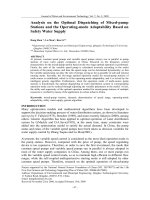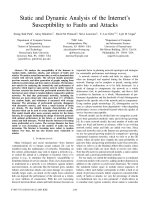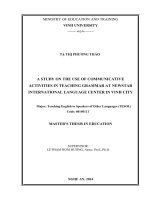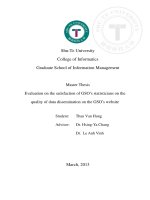VCBS COMPANY BACKGROUND AND SWOT ANALYSIS ON THE COMPANY’S BROKERAGE ACTIVITIES
Bạn đang xem bản rút gọn của tài liệu. Xem và tải ngay bản đầy đủ của tài liệu tại đây (416.85 KB, 74 trang )
ACKNOWLEDGEMENT
Thesis is an important part for each student of CFVG. First and foremost, I
would like to express my sincere thanks and appreciation to Ass.Pr.Dr Vu Thanh
Hung for his devoted assistant to me during my preparation and research for this
thesis. Thanks to his valuable and detailed guidance and suggestions, I have finished
this dissertation successfully.
I would like to express my thankfulness to all teachers in CFVG, who have
directed and supplied me the necessary knowledge during the time at CFVG and Ma.
Do Cong Duc, the manager of Strategic planning Department of Vietcombank
Securities Company for data collection and useful advice in my analysis.
1
ABBREVIATION & DEFINITION
VCBS VietComBank Securities Company
IPO Initial Public Offering
OTC Over the Counter Market
SSC State Securities Committee
HOSE Ho Chi Minh Stock Exchange
HNX Hanoi Stock Exchange
VSD Vietnam securities depository centre
UPCOM The Unlisted Public Company Market
SSI Saigon Securities Incorporation
ACBS Asia Commercial Bank Securities Company
TSC Thang Long Securities Company
FSC First Class Securities Company
ABS An Binh Bank Securities Company
HSC Ho Chi Minh Securities Company
SBS Sacombank Securities Company
KLS Kim Long Securities Company
BVS Bao Viet Securities Company
KEVS KimEng Securities Company
PTSC Petro Vietnam technique and servicesCompany
Short Sale Borrowing a security (or commodity futures contract) from a broker
and selling it, with the understanding that it must later be bought
back (hopefully at a lower price) and returned to the broker.
Margin Account or Margin trading: is a brokerage account in which the
Broker lends the customer cash with which to purchase
securities. Unlike a cash account, a margin account allows an
investor to buy securities with money that he/she does not have, by
borrowing the money from the broker.
2
TABLE OF CONTENT
ACKNOWLEDGEMENT 1
ABBREVIATION & DEFINITION 2
TABLE OF CONTENT 3
DISSERTATION INTRODUCTION 7
1.Reasonable 7
2.Objectives 7
3.Methodology 8
4.Scope 8
5.Dissertation structure 9
CHAPTER I: THEORETICAL FRAMEWORK 10
& LITERATURE REVIEW 10
1.Strategic management 10
1.1Concepts strategic management 10
1.2Characteristics of strategic management 11
1.2.1 The elements of strategy implementation 11
1.2.2 The elements of strategy evaluation 11
2.SWOT analysis 12
Table 1: SWOT analysis model 13
2.1 PEST model 13
2.1.1 Concept of PEST model 13
2.1.2 Factors of PEST 14
2.2.1 Product life cycles 15
Table 2: Product life cycle 17
2.2.2 BCG Matrix 18
Table 3: BCG Matrix 20
2.2.3 Michael Porter five forces model 20
Table 4: Michael Porter competitive Five forces model 24
2.3 Internal Analysis 24
2.4 TOWS matrix 25
3.Brokerage 26
3.1 Concept of brokerage 26
3.2 Types of Stock brokers 26
3.3Stock Broker activities in Viet Nam 27
CHAPTER II: VCBS COMPANY BACKGROUND AND SWOT
ANALYSIS ON THE COMPANY’S BROKERAGE ACTIVITIES 28
1.Company Background 28
1.1Overview 28
Table 5: VCBS company structure 28
1.2Range of business 29
1.3VCBS Partners 29
1.4VCBS mission & objectives 29
1.5VCBS business activities 31
1.6VCBS Business Performance 33
Table 6: Total Assets 2003 – 2009 (billion dongs) 33
Table 7: Turnover and Profit 2004 – 2009 (billion dongs) 34
3
1.7VCBS brokerage performance 35
Table 8: VCBS Brokerage Department Structure 35
Table 9: VCBS brokerage turnover (billion dongs) 36
Table 10: Top 10 biggest securities companies in brokerage 37
2. External analysis 37
2.1 PEST analysis 38
2.1.1 Political and legal factors 38
2.1.2 Economic factors 39
2.1.3 Social factors 40
2.1.4 Technological factors 41
Table 11: Key external factors evaluation (EFE) on VCBS brokerage
activities 42
2.2 Industry analysis 44
2.2.1 General analysis 44
Table 12: Securities trading account statistics in July 2009 45
2.2.2 Five forces analysis 46
2.2.2.1 Potentiality of new entrants (rather low) 46
2.2.2.2 Bargaining power of Suppliers (low): 46
2.2.2.3 Bargaining power of Buyers (high): 47
2.2.2.4 Threats of Substitutes (rather high): 47
2.2.3 Product life cycle (PLC) analysis 48
2.2.4 BCG analysis 48
Table 13: VCBS Position at BCG Matrix 49
2.3 VCBS Brokerage internal analysis 49
2.3.1 Strengths 49
Table 14: VCBS brokerage forces 51
Table 15: Securities account statistics 54
2.3.2 Weaknesses 54
Table 16: Key internal factors evaluation (IFE) on VCBS brokerage
activities 56
CHAPTER III: SUITABLE STRATEGIES SOLUTIONS TO
STRENGTHEN BROKERAGE ACTIVITIES IN VCBS 58
1. The goals of brokerage activities in 2009-2013 58
Table 17: VCBS brokerage objectives in the period of 2009-2013 58
2. General strategies 59
2.1 Market penetration 60
2.2 Market development 61
2.3 Product development 62
3. Specific solutions to implement the intensive strategy for VCBS brokerage
activities 63
3.1 Building up a high tech information system for VCBS brokerage activities.63
3.2 Implementing specializing human resources structure, providing more
training, building up a clear career road maps 64
3.2.1 Restructuring human resources for VCBS brokerage department 64
3.2.2 Providing more trainings, setting up a clear career road map and
establishing encourage bonus range for staff 65
3.2.3 Applying ISO procedure in brokerage activities 65
3.3 Bigger investment to finance intensive strategy for VCBS brokerage
activities 66
4
3.3.1 Financing marketing activities for market penetration strategy 66
3.3.2 Financing marketing activities for market development activities 66
Table 19: Estimated cost of VCBS new establishment (VND mil/year) 66
3.4 Creating clear, planned and reasonable marketing campaign 67
3.4.1 Setting up a reasonable wide range of brokerage fee: 67
3.4.2 Providing more convenient securities services for potential customers: 67
3.4.3 Building up a strong and supporting distribution network: 68
3.4.4 Organizing regular conferences, training courses and introduction seminars
for customers: 68
4. Expected results when applying an intensive strategy for VCBS brokerage
activities 68
Table 20: Expected VCBS brokerage activities results 70
70
CONSLUSION 71
REFERENCES 72
5
LIST OF TABLES AND FIGURES
ACKNOWLEDGEMENT 1
ABBREVIATION & DEFINITION 2
TABLE OF CONTENT 3
DISSERTATION INTRODUCTION 7
CHAPTER I: THEORETICAL FRAMEWORK 10
& LITERATURE REVIEW 10
Table 1: SWOT analysis model 13
Table 2: Product life cycle 17
Table 3: BCG Matrix 20
Table 4: Michael Porter competitive Five forces model 24
CHAPTER II: VCBS COMPANY BACKGROUND AND SWOT
ANALYSIS ON THE COMPANY’S BROKERAGE ACTIVITIES 28
Table 5: VCBS company structure 28
Table 6: Total Assets 2003 – 2009 (billion dongs) 33
Table 7: Turnover and Profit 2004 – 2009 (billion dongs) 34
Table 8: VCBS Brokerage Department Structure 35
Table 9: VCBS brokerage turnover (billion dongs) 36
Table 10: Top 10 biggest securities companies in brokerage 37
Table 11: Key external factors evaluation (EFE) on VCBS brokerage
activities 42
Table 12: Securities trading account statistics in July 2009 45
Table 13: VCBS Position at BCG Matrix 49
Table 14: VCBS brokerage forces 51
Table 15: Securities account statistics 54
Table 16: Key internal factors evaluation (IFE) on VCBS brokerage
activities 56
CHAPTER III: SUITABLE STRATEGIES SOLUTIONS TO
STRENGTHEN BROKERAGE ACTIVITIES IN VCBS 58
Table 17: VCBS brokerage objectives in the period of 2009-2013 58
Table 19: Estimated cost of VCBS new establishment (VND mil/year) 66
Table 20: Expected VCBS brokerage activities results 70
70
CONSLUSION 71
REFERENCES 72
6
DISSERTATION INTRODUCTION
1. Reasonable
From the Renovation in 1986, Vietnam’s economy has made many vital
achievements. It overcame the financial crisis in 1997 and maintained a very
strong economic growth rate nearly at 7% during the period of 2004-2009. In
addition, Vietnam has gained a lot of impressive results in macro – economic
stabilities, FDI, export growth, hunger elimination and especially in capital
market. The Vietnam stock market is one of three capital markets in Vietnam and
is rather young market in the world financial market with nearly 10 year old
(HOSE initially established in July 2000).
Up to now, there are around 100 securities companies in Vietnam Stock
market and almost are not familiar with the advantage of using strategies in their
business. The business activities of one Securities Company have three main parts
consisting of brokerage, investment and corporate finance consultancy. Normally,
brokerage business takes no risks and contributes about 40%-50% of total revenue
to the company. So, the applying of strategies to brokerage activities is one of the
most important things that securities companies should take into account.
Vietcombank Securities Company is one of the three biggest securities
company in Vietnam and like many companies in this sector, it didn’t have any
specific and professional business strategies in its brokerage activities. As a result,
the brokerage activities of VCBS face a lot of difficulty in keeping pace with the
planning sales growth rate and how to prepare finance, human resources,
information system and marketing campaign to achieve posed objectives.
With the knowledge gathering in CFVG and the tutor’s instructions, I am going
to introduce the reality of brokerage activities in VCBS and strategies solutions to
solve these problems.
2. Objectives
The dissertation is aimed at the following purposes:
7
- Summary relating theories of strategic management, and point out
application of these theory in VCBS
- Identify opportunities, threats, strengths and weaknesses of VCBS
- Make general and specific strategic solutions to VCBS brokerage activities
3. Methodology
- Sources of information:
+ Primary data: via interview, observations, and survey…
+ Secondary data: Through books, publications, reports, cases, websites…
- Methodology:
+ Interview managers and staff of Brokerage Department of VCBS
+ Collect related data and information from prospectuses, annual reports,
financial statements of VCBS and reports from relevant state agencies
+ Access websites of specific organizations (State securities committee,
Ho Chi Minh stock exchange…) to gather relevant data and useful
information to complete the study as well as to make solutions and
recommendations for improving performance of brokerage activities in
VCBS
+ Use general, analytical, comparative and statistical methods with charts,
tables and factual figures for support
4. Scope
Due to time limitation and data unavailability, I am going to do research
on brokerage activities in VCBS (other business activities such as corporate
finance consultancy and investment are not mentioned in this study) and my
study only focuses on the brokerage activities of VCBS from 2004 to the first
half of 2009
8
5. Dissertation structure
This Dissertation named “Suitable strategies to strengthen Vietcombank
securities company brokerage activities” is divided into five parts as follows;
- Introduction
- Chapter I: Theoretical frameworks & literature review
- Chapter II: VCBS company background & SWOT analysis on the
company’s brokerage activities
- Chapter III: Brokerage Strategies to improve VCBS brokerage activities
- Conclusion
9
CHAPTER I: THEORETICAL FRAMEWORK
& LITERATURE REVIEW
1. Strategic management
1.1 Concepts strategic management
The term of strategic management is usually used with the term of strategic
planning. The term strategic planning originated in 1950s and was very familiar
between 1960s and 1970s. During these years, strategic planning was widely
believed to answer for all problems related to companies’ activities. Following
that “boom” however, strategic planning was cast aside during the 1980s as
various planning models did not yield higher returns. The 1990s, however,
brought the revival of strategic planning and the process is widely used in world
business today.
There are several definitions of strategic management or strategic planning as
follows:
“Strategic management can be defined as the art and science of formulating,
implementing, and evaluating cross-functional decisions that enable an
organization to achieve its objectives”
1
.
Or “Strategic management is an ongoing process that evaluates and controls
the business and the industries in which the company is involved; assesses its
competitors and sets goals and strategies to meet all existing and potential
competitors; and then reassesses each strategy annually or quarterly [i.e. regularly]
to determine how it has been implemented and whether it has succeeded or needs
replacement by a new strategy to meet changed circumstances, new technology,
new competitors, a new economic environment., or a new social, financial, or
political environment”
2
.
To sum up, strategic management is the conduct of drafting, implementing and
evaluating cross-functional decisions that will enable an organization to achieve
1
Fred. Davis – Strategic management concepts & cases, page 5
2
Lamb, Robert, Boyden Competitive strategic management, Englewood Cliffs, NJ: Prentice-Hall, 1984
10
its long-term objectives.
1.2 Characteristics of strategic management
The strategic management process consists of three stages: strategic
formulation, strategic implementation and strategic evaluation.
The strategic formulation includes developing a vision and mission, identifying
an organization’s external opportunities and threats, determining internal strengths
and weaknesses, establishing long term objectives, generating alternative
strategies and choosing a particular strategy to pursue
1.2.1 The elements of strategy implementation
The strategy implementation includes:
• Allocation and management of sufficient resources (financial, personnel,
operational support, time, technology support)
• Establishing a chain of command or some alternative structure (such as cross
functional teams)
• Assigning responsibility of specific tasks or processes to specific individuals
or groups
• It also involves managing the process. This includes monitoring results,
comparing to benchmarks and best practices, evaluating the efficacy and
efficiency of the process, controlling for variances, and making adjustments to
the process as necessary.
• When implementing specific programs, this involves acquiring the requisite
resources, developing the process, training, process testing, documentation,
and integration with (and/or conversion from) legacy processes.
1.2.2 The elements of strategy evaluation
The Strategy evaluation consists of: Measuring the effectiveness of the
organizational strategy, it's extremely important to conduct a SWOT analysis to figure
out the strengths, weaknesses, opportunities and threats (both internal and external) of
11
the entity in question. This may require to take certain precautionary measures or even
to change the entire strategy.
In corporate strategy, Johnson and Scholes present a model in which strategic
options are evaluated against three key success indicators such as Suitability (would it
work?); Feasibility (can it be made to work?) ; Acceptability (will they work it?)
There are some main types of strategic management from corporate level unit
level such as: corporate strategy (for the whole organization), business strategy (for
business segment or division), and functional strategy (for business units). An
additional level of strategy called operational strategy was encouraged by Peter
Drucker in his theory of management by objectives (MBO). It is very narrow in focus
and deals with day-to-day operational activities such as scheduling criteria. It must
operate within a budget but is not at liberty to adjust or create that budget. Operational
level strategies are informed by business level strategies which, in turn, are informed
by corporate level strategies.
2. SWOT analysis
SWOT Analysis is a strategic planning method used to evaluate the Strengths,
Weaknesses, Opportunities, and Threats involved in a project or in a business
venture
3
. It involves specifying the objective of the business venture or project and
identifying the internal and external factors that are favorable and unfavorable to
achieving that objective. The technique is credited to Albert Humphrey, who led a
convention at Stanford University in the 1960s and 1970s using data from Fortune
500 companies.
Four elements of SWOT analysis are:
• Strengths: attributes of the person or company that is helpful to
achieving the objective.
• Weaknesses: attributes of the person or company that is harmful to
achieving the objective.
3
Hill, T. & R. Westbrook (1997). "SWOT Analysis: It’s Time for a Product Recall". Long Range
Planning 30
12
• Opportunities: external conditions that is helpful to achieving the
objective.
• Threats: external conditions which could do damage to the business's
performance.
Identification of SWOT is essential because subsequent steps in the process of
planning for achievement of the selected objective may be derived from the SWOT.
First, the decision makers have to determine whether the objective is attainable, given
the SWOT. If the objective is NOT attainable a different objective must be selected
and the process repeated. The SWOT analysis is often used in academia to highlight
and identify strengths, weaknesses, opportunities and threats. It is particularly helpful
in identifying areas for development
Table 1: SWOT analysis model
SWOT analysis
Helpful to achieve the
objectives
Harmful to achieve the
objectives
Internal origin
(attributes of the
organizations)
Strength(S) Weaknesses(W)
External origin
(attributes of the
environment)
Opportunities(O) Threats(T)
Sources:Pr.Dr Le The Gioi &Dr. Nguyen Thanh Liem, 2007, Statistics hall, 2
nd
edition,”Strategic Management”, pp 9
2.1 PEST model
2.1.1 Concept of PEST model
PEST analysis stands for "Political, Economic, Social, and Technological
analysis" and describes a framework of macro-environmental factors used in the
13
environmental scanning component of strategic management
4
. The model has recently
been further extended to STEEPLE and STEEPLED, adding education and
demographics factors. It is a part of the external analysis when conducting a strategic
analysis or doing market research and gives a certain overview of the different macro
environmental factors that the company has to take into consideration. It is a useful
strategic tool for understanding market growth or decline, business position, potential
and direction for operations.
The growing importance of environmental or ecological factors in the first decade
of the 21st century have given rise to green business and encouraged widespread use
of an updated version of the PEST framework. STEER analysis systematically
considers Socio-cultural, Technological, Economic, Ecological, and Regulatory
factors.
2.1.2 Factors of PEST
The purpose of the external audit is to develop a finite list of opportunities that
can benefit a company and threats should be avoided. When the term finite suggests,
the external audit is not aimed at developing and exhaustive list of every possible
factor that could influence the business. Thus, firms are able to respond either
offensively or defensively to the factors by formulating strategies that take advantages
of external opportunities or that minimize the influence of potential threats. External
forces ca be divided into five board of categories as follows:
• Political: Specifically, political factors include areas such as tax policy, labor
law, environmental law, trade restrictions, tariffs, and political stability.
Political factors may also include goods and services which the government
wants to provide or be provided (merit goods) and those that the government
does not want to be provided (demerit goods or merit bad). Furthermore,
governments have great influence on the health, education, and infrastructure
of a nation.
• Economic factors include economic growth, interest rates, exchange rates and
the inflation rate. These factors have major impacts on how businesses operate
4
"PEST: Political, Economic, Social, and Technology Analysis". The Decision Group.
Retrieved 2009-01-27
14
and make decisions. For example, interest rates affect a firm's cost of capital
and therefore to what extent a business grows and expands. Exchange rates
affect the costs of exporting goods and the supply and price of imported goods
in an economy
• Social factors include the cultural aspects and include health consciousness,
population growth rate, age distribution, career attitudes and emphasis on
safety. Trends in social factors affect the demand for a company's products
and how that company operates. For example, an ageing population may
imply a smaller and less-willing workforce (thus increasing the cost of labor).
Furthermore, companies may change various management strategies to adapt
to these social trends (such as recruiting older workers).
• Technological factors include ecological and environmental aspects, such as
R&D activity, automation, technology incentives and the rate of technological
change. They can determine barriers to entry, minimum efficient production
level and influence outsourcing decisions. Furthermore, technological shifts
can affect costs, quality, and lead to innovation.
• Legal factors include discrimination law, consumer law, antitrust law,
employment law, and health and safety law. These factors can affect how a
company operates, its costs, and the demand for its products.
• Environmental factors include weather, climate, and climate change, which
may especially affect industries such as tourism, farming, and insurance.
Furthermore, growing awareness to climate change is affecting how
companies operate and the products they offer it is both creating new markets
and diminishing or destroying existing ones.
2.2 Industry analysis
2.2.1 Product life cycles
The product life cycle goes through many phases, involves many professional
disciplines, and requires many skills, tools and processes. Product life cycle (PLC)
has to do with the life of a product in the market with respect to business/commercial
15
costs and sales measures; whereas product life cycle management (PLM) has more to
do with managing descriptions and properties of a product through its development
and useful life, mainly from a business/engineering point of view. To say that a
product has a life cycle is to assert four things: 1) that products have a limited life, 2)
product sales pass through distinct stages, each posing different challenges,
opportunities, and problems to the seller, 3) profits rise and fall at different stages of
product life cycle, and 4) products require different marketing, financial,
manufacturing, purchasing, and human resource strategies in each life cycle stage.
16
Table 2: Product life cycle
Sources:Pr.Dr Le The Gioi &Dr. Nguyen Thanh Liem, 2007, Statistics Hall, 2
nd
edition,”Strategic Management”, pp 128
Even though its validity is questionable, it can offer a useful 'model' for managers
to keep at the back of their mind. Indeed, if their products are in the introductory or
growth phases, or in that of decline, it perhaps should be at the front of their mind; for
the predominant features of these phases may be those revolving around such life and
death. Between these two extremes, it is salutary for them to have that vision of
mortality in front of them.
However, the most important aspect of product life-cycles is that, even under
normal conditions, to all practical intents and purposes they often do not exist (hence,
there needs to be more emphasis on model/reality mappings). In most markets the
majority of the major brands have held their position for at least two decades. The
I
N
R
R
O
D
U
C
T
I
O
N
G
R
O
W
T
H
M
A
T
U
R
I
T
Y
D
E
C
L
I
N
E
TIME
SALES IN $ OR VOLUME
17
dominant product life-cycle, that of the brand leaders which almost monopolize many
markets, is therefore one of continuity.
2.2.2 BCG Matrix
The BCG (Boston consultancy group) is based on the product life cycle theory
which could be used to determine what priorities should be given in the product
portfolio of a business unit. To make sure long term value creation, a corporate should
have a portfolio product that consists of both high grow products in need of cash
inputs and low growth products which create a lot of cash. The model has two
dimensions which are market share and market growth. The basic idea behind it is
that the bigger the market share a product has or the faster the product’s market grows
the better it is for the company.
Placing products in the BCG matrix results in four categories in a portfolio of
a company as follows:
- Stars (means high growth and high market share): In this position, a
company should use large amount of cash and are leader of its business so
they should also make larger profit. Because the rewards will be a cash
cow if the market share is kept, a company is frequently rough in balance
on cash flows
- Cash cow (means low growth and high market share): In this stage, the
company’s profit and cash generation should be high and because of low
growth, the investment should be low and keep the margin high. So, we
need to take consider a new business to invest.
- Dogs (means low growth and low market share): In this position, the
company should avoid and minimize the number of dogs in the company.
Hence, it has to be aware of expensive “turn around plans”
- Question marks (means high growth and low market share) In this stage,
the company has the worst cash position due to high demand and low
revenues because of low market share. If nothing done to change the
18
market share ratio, question mark will simply absorb great amounts of
cash and then, as the growth stops, a dog will be appeared.
The BCG Matrix method can help to understand a frequently made strategy
mistake and has one –size- fits- all- approach to strategy. The BCG has some
limitation such as: high market share is not the only successful factor, market growth
is not the only indicator for the market’s attractiveness, and in some times, dogs will
earn more cash than cash cow does.
19
Table 3: BCG Matrix
RELATIVE MARKET SHARE
(Cash Generation)
STARS
QUESTION MARKS
CASH COWS
DOGS
Sources: />2.2.3 Michael Porter five forces model
Porter's five forces analysis is a framework for the industry analysis and
business strategy development developed by Michael E. Porter of Harvard Business
School in 1979
5
. It uses concepts developed in Industrial Organization (IO)
economics to derive five forces which determine the competitive intensity and
therefore attractiveness of a market. Attractiveness in this context refers to the overall
industry profitability. An "unattractive" industry is one where the combination of
5
Porter, M.E. (1980) Competitive Strategy, Free Press, New York, 1980
20
MARKET GROWTH RATE
(Cash Usage)
Low
High
High Low
forces acts to drive down overall profitability. A very unattractive industry would be
one approaching "pure competition".
Porter referred to these forces as the micro environment, to contrast it with the
more general term macro environment. They consist of those forces close to a
company that affect its ability to serve its customers and make a profit. A change in
any of the forces normally requires a company to re-assess the marketplace. The
overall industry attractiveness does not imply that every firm in the industry will
return the same profitability. Firms are able to apply their core competences, business
model or network to achieve a profit above the industry average. A clear example of
this is the airline industry. As an industry, profitability is low and yet individual
companies, by applying unique business models have been able to make a return in
excess of the industry average.
Five forces of Michael porter five forces model describe as follows:
A. The threat of substitute products
The existence of close substitute products increases the propensity of customers to
switch to alternatives in response to price increases (high elasticity of demand buyer
propensity to substitute)
• relative price performance of substitutes
• buyer switching costs
• perceived level of product differentiation
B. The threat of the entry of new competitors
Profitable markets that yield high returns will draw firms. This results in many new
entrants, which will effectively decrease profitability. Unless the entry of new firms
can be blocked by incumbents, the profit rate will fall towards a competitive level
(perfect competition).
• The existence of barriers to entry (patents, rights, etc.)
• economies of product differences
21
• brand equity
• switching costs or sunk costs
• capital requirements
• access to distribution
• absolute cost advantages
• learning curve advantages
• expected retaliation by incumbents
• government policies
C. The intensity of competitive rivalry
For most industries, this is the major determinant of the competitiveness of the
industry. Sometimes rivals compete aggressively and sometimes rivals compete in
non-price dimensions such as innovation, marketing, etc.
• number of competitors
• rate of industry growth
• intermittent industry overcapacity
• exit barriers
• diversity of competitors
• informational complexity and asymmetry
• fixed cost allocation per value added
• level of advertising expense
• Economies of scale
• Sustainable competitive advantage through improvisation
22
D. The bargaining power of customers
The ability of customers to put the firm under pressure and it also affects the
customer's sensitivity to price changes.
• buyer concentration to firm concentration ratio
• degree of dependency upon existing channels of distribution
• bargaining leverage, particularly in industries with high fixed costs
• buyer volume
• buyer switching costs relative to firm switching costs
• buyer information availability
• ability to backward integrate
• availability of existing substitute products
• buyer price sensitivity
• differential advantage (uniqueness) of industry products
• RFM Analysis
E. The bargaining power of suppliers
Also described as market of inputs, Suppliers of raw materials, components, labor,
and services (such as expertise) to the firm can be a source of power over the firm.
Suppliers may refuse to work with the firm, or e.g. charge excessively high prices for
unique resources.
• supplier switching costs relative to firm switching costs
• degree of differentiation of inputs
• presence of substitute inputs
• supplier concentration to firm concentration ratio
23
• employee solidarity (e.g. labor unions)
• threat of forward integration by suppliers relative to the threat of backward
integration by firms
• Cost of inputs relative to selling price of the product.
Table 4: Michael Porter competitive Five forces model
Sources: K.C Robinson & P.P.Mcdougall,2001,”Entry Barriers and News
Venture performance a comparison of Universal and Contingency Approaches”,
Strategic Management Journal, 16pp 535-549
2.3 Internal Analysis
The Internal Analysis of strengths and weaknesses focuses on internal factors
that give an organization certain advantages and disadvantages in meeting the needs
of its target market. Strengths refer to core competencies that give the firm an
advantage in meeting the needs of its target markets. Any analysis of company
strengths should be market oriented/customer focused because strengths are only
meaningful when they assist the firm in meeting customer needs. Weaknesses refer to
any limitations a company faces in developing or implementing a strategy.
Competitive
Rivalry
Within an
Industry
Threat of
Substitute
Product
Bargaining
Power of
Suppliers
Threat of
New
Entrants
Bargaining
Power of
Customers
24
Weaknesses should also be examined from a customer perspective because customers
often perceive weaknesses that a company cannot see. Being market focused when
analyzing strengths and weaknesses does not mean that non-market oriented strengths
and weaknesses should be forgotten. Rather, it suggests that all firms should tie their
strengths and weaknesses to customer requirements. Only those strengths that relate to
satisfying a customer need should be considered true core competencies. (Marketing
and Its Environment, pg 44)
The following area analyses are used to look at all internal factors effecting a
company:
• Resources: Profitability, sales, product quality brand associations, existing
overall brands, relative cost of this new product, human resources capability,
product portfolio analysis
• Goal: To identify internal strategic strengths, weaknesses, problems,
constraints and uncertainties
2.4 TOWS matrix
The Threats-Opportunities-Weaknesses-Strengths (TOWS) Matrix is an
important matching tool that helps managers to develop four types of strategies:
SO Strategies, WO Strategies, ST Strategies, and WT Strategies. TOWS Matrix
could be applied to the development of tactics necessary to implement the
strategies, and to more specific actions supportive of tactics.
SO Strategies use a firm's internal strengths to take advantage of external
opportunities. All managers would like their organizations to be in a position
where internal strengths can be used to take advantage of external trends and
events. For example, Mercedes Benz, with the technical know-how and the quality
image (strength), can take advantage of the external demand for luxury cars
(opportunity) by an increasingly affluent public.
WO Strategies aim at improving internal weaknesses by taking advantage of
external opportunities. Sometimes key external opportunities exist, but a firm has
internal weaknesses may prevent it from exploiting those opportunities. For
example, an auto accessory company with a great demand for electronic devices
25




![thang nguyen ngoc - 2011 - corporate governance and its impact on the performance of firms in emerging countries - the evidence from vietnam [cg]](https://media.store123doc.com/images/document/2015_01/02/medium_rfd1420194809.jpg)
![thang nguyen ngoc - 2011 - corporate governance and its impact on the performance of firms in emerging countries - the evidence from vietnam [cg]](https://media.store123doc.com/images/document/2015_01/06/medium_tlw1420548434.jpg)



